Mini-Review :
Stephen K Reed and Michel Dumontier The goal of the NIMH RDoC initiative is to
establish a biological basis for mental illness that includes linking cognition
to molecular biology. A key challenge lies in how to represent such large,
complex, and multi-scale knowledge in a manner that can support computational
analysis, including query answering. Formal ontologies, such as the
Semanticscience Integrated Ontology (SIO), offer a scaffold in which complex
domain knowledge such as neurological and cognitive functions can be
represented and linked to knowledge of molecular biology. In this article, we
explore the use of SIO to represent concepts in molecular biology and in
cognition. We extend SIO to traditional cognitive topics by illustrating axioms
for both an information-processing and a neuroscience perspective on reading.
We next discuss the NIMH RDoC taxonomy and include SIO axioms for the
units-of-analysis and functions-of-behavior dimensions. An example demonstrates
its use of deductive reasoning to establish causal relations across RDoC
dimensions. From a broader perspective this article demonstrates how
informatics can assist in integrating work in clinical psychology, cognitive
psychology, cognitive neuroscience, computer science, molecular biology, and
philosophy. The use of computers to organize information, often labeled
informatics, is becoming increasingly necessary to impose some structure on a
large and diverse array of data [1]. The fields of biology and medicine are
leading the way as revealed by the frequent use of the term bioinformatics. A
search of Google Scholar in 2012 returned over 1 million hits for
bioinformatics compared to only 18 hits for the term psychoinformatics [2]. The
extensive work in the field of bioinformatics and the increasing emphasis on
the biological basis of behavior creates an opportunity to include more
cognitive processes to enhance informatics. For example, new insights into the neural basis of normal
and abnormal behavior have resulted in reconsideration of syndromes, once considered
exclusively mental, as brain disorders that can disrupt neural, cognitive, and
behavioral systems [3]. The NIMH Research Domain Criteria (RDoC) initiative
organizes research according to a taxonomy that relates units of analysis (such
as genes, molecules, cells, and circuits) to functional dimensions of behavior
(negative affect, positive affect, cognitive systems, social processes, and
arousal/regulatory systems). Although taxonomies provide a plan for organizing
knowledge, formal ontologies such as the Suggested Upper Merged Ontology (SUMO)
provide a detailed theoretical framework for organizing knowledge [4-5]. Formal ontologies consist of both a hierarchy that
decomposes knowledge from the general to the specific and a logic that allows
deductive reasoning. Leaders in the fields of neuroscience and informatics
suggest that the use of upper-level ontologies and the assignment of semantic
relations between terms in mental ontologies will enhance knowledge integration
[1]. Articles on the application of Information Science tools (ontologies,
WordNet, FrameNet) to Psychology [3] and on distinctions among Psychology ontologies
[6] discuss progress in meeting this objective. The purpose of this article is to introduce and then expand
the application of a more specialized ontology for bioinformatics. The
Semanticscience Integrated Ontology (SIO) builds on the Ontology Web Language
(OWL), which has a less powerful logic than SUMO but is easier to learn. OWL is
a formal knowledge representation language with a vocabulary for expressing
knowledge of types, relations, individuals, and data values. It uses a (RDF)
format to describe entities in terms of their types, attributes and relations
to other entities such as nucleus part of cell [7]. SIO is a practical ontology consisting of a broad set of
upper- and mid-level terms that can be coupled with a minimal set of domain-independent
relations to richly represent knowledge through a set of simple design patterns
[8]. Its framework is believed to be sufficiently flexible to accommodate a
wide range of data. Our objective in this article is therefore to extend SIOs
application from its current focus on molecular biology to include cognitive
processes. We are particularly motivated by the RDoC initiative of establishing
a biological basis for cognitive behavior that links cognition to molecular
biology. SIO could provide a common language for this integration. The next section provides an overview of SIO and shows how
it organizes knowledge in the life sciences [8]. Section 3 extends its
application to cognition to represent both an information-processing and a
neuroscience perspective on reading. Section 4 discusses the NIMH RDoC taxonomy
and then illustrates SIO descriptions for the units of analysis and the
functions-of-behavior dimensions. All of these extensions include SIO axioms to
demonstrate their capability to formalize statements about cognitive
processing. The theoretical content of these axioms, however, would need to be
qualified by combining them with other axioms for large-scale applications.
Section 5 illustrates the use of these axioms to answer an RDoC query. Section
6 compares SIO with related work and Section 7 makes several concluding
remarks. Foundational model Table 1: Some Key SIO Definitions. An object is an entity that occupies space and is fully
identifiable by its attributes at any moment in time. For example, a person is
a kind of object because they have mass and can occupy space; and we can
recognize a person even though they gain (e.g. a benign growth) or lose parts
(e.g. an arm) over their lifetime. In contrast, a process is an entity that
unfolds in time and has temporal parts. It includes behavior, broadly defined
in SIO as the set of actions and mannerisms made by systems (biological or
otherwise) in response to stimuli or inputs, whether internal or external,
conscious or subconscious, overt or covert, and voluntary or involuntary. An attribute
is either an intrinsic quality or realizable through a capability or role
(Figure 1A). Examples are the brown color of hair as an intrinsic physical
quality, the capability to breathe air, and the extrinsic social role of being
a judge. The basis for a capability lies in one or more parts and/or qualities,
and reflects possibility of an entity to act in a specified way under certain
conditions. The ability to act (agency) only requires that a particular entity
has the physical basis to behave in the way specified. SIOs objects and
capabilities are not necessarily driven by elements of consciousness. Relations, shown in Figure 1B, include has attribute, is
located in, and represents. While all SIO entities (object, processes,
attributes) exist at and are located in some time and space, these are not
necessarily real space or real time. Thus, SIO supports the description of
objects, processes and attributes arising from a mental representation using
any part of terminology that also describes real world objects. One limitation
of this approach is that SIO is constructed with axioms to describe the
attributes and relations of real world objects and processes, which may not
hold in fictional, mental, or virtual environments. Figure
1a: Selected portions of class hierarchies
in SIO. Figure 1b: Selected portions of object-property
hierarchies in SIO. Some key objects and relations are diagrammed in Figure 2A.
Processes have objects as participants that can realize specific roles and capabilities.
SIOs representation allows for the capability or role of an object to become
realized as a process that has value quality or measurement value and can
result in new processes, objects, or their attributes. For instance, anxiety
could be represented as: A student (object) has an anxiety trait (disposition)
that is realized in taking a test (process) of a particular duration (measurement
value) and resulting in poor performance (measurement value). A disposition is
the tendency of a capability to be exhibited under certain conditions (taking a
test) or in response to a certain stimulus (encountering a difficult question).
Therefore, a capability in SIO is about the mere possibility while a disposition
focuses on the likelihood. Other key entities in SIO are space, time (Figure 2B), and information
(Figure 2C), which we discuss later. Space and time are considered objects in
SIO and can occupy some portion of space and exist in some portion of time.
Information content entities focus on symbolic representations that convey some
meaning. For instance, the composition and topology of a protein or class of
proteins can be represented by a protein sequence-a ordered list in which each
letter in the string denotes a specific type of amino acid. Figure
2: Key entities and relations in SIO. Application to
molecular biology Figure 3a shows an application of SIO entities and relations
to molecular biology including that organs, cells, and molecules are parts of
an organism and a phenotype is an attribute of an organism. The overlap of one
concept on another indicates a subclass relation, such as a gene is a subclass
of a DNA region. Many other relations, such as is attribute of and has part,
are also frequently used to organize knowledge. Fig. 3a shows that a phenotype
is is attribute of an organism and an organism has part cells. An important relation in molecular biology is encodes,
defined by SIO as a relation between two objects in which the first object
contains information that is used to produce the second object. Figure 1b and
3a distinguish between two types of encoding used in genetics – translated from
and transcribed from. is transcribed into is a relation in which the
information encoded in one object produces an exact or similar kind of
object. For instance, in classical
molecular biology RNA molecules are assembled by molecular machines capable of
reading and interpreting DNA-based genes. DNA and RNA are structurally quite
similar in terms of their nucleotide composition, but have different roles in
the cell regarding information storage and transfer. Is translated into
describes a relation in which a completely different kind of entity is
generated as a result of a process that uses the information from the source
object. For instance, RNA molecules are interpreted by molecular machines to
produce proteins. The theme of this article is that SIO can be extended from
molecular biology to cognition and therefore serve as a foundation for
establishing closer connections across the biological and cognitive sciences.
Section 3.1 summarizes how SIO represents information for subsequent
application to how people encode and store it. The next two sections show an
application to reading text from a traditional information-processing
perspective (Section 3.2) and from a more recent neuroscience perspective (Section
3.3). This comparison enables us to demonstrate SIOs flexibility in describing
cognition from different perspectives. Information Informational entities exist independently of any particular
physical manifestation, although there must have been at least one
manifestation (a physical embodiment in the past or present). Information
content entities are informational entities that can be concretized as
characteristics (ink pattern, electromagnetic pattern, and neuronal pattern) of
physical entities (a page, a hard drive, a brain). Figure 1a shows that an information content entity includes
a language entity consisting of a visual language entity and a verbal language
entity that will be used in our discussion of reading. A verbal language entity
is manifested through sound. A visual language entity is manifested through
light and can be perceived and processed by a visual system. Our intention is
both to apply current SIO terminology and create new terminology that can
facilitate the comparison of information across the various grain sizes of
genes, molecules, cells, brain circuits and behavior. Such a language should be
useful not only for comparisons across the RDoC units of analysis but for the
description of traditional topics such as the cognitive processes involved in
reading. The next two sections describe these processes from an
information-processing and a neuroscience perspective. Application to an
information-processing model of reading Reading requires using background knowledge to decode a textual
entity into a representation that is mentally accessible. The generation of a
verbal representation requires encoding this representation into a
speech-based, phonological code (verbal language entity) and as a meaning-based
semantic code based on morphemes. A morpheme is a basic unit of meaning that is
used to construct the meaning of words. Morphemes consist of stem words,
prefixes and suffixes. The word unfriendly consists of the stem word friend,
the suffix ly and the prefix un. Notice how each morpheme changes the meaning
of the word. The first axiom in Figure 4 states that a textual entity is
translated into words consisting of morphemes. In addition to representing meaning as morphemes readers
sometimes create visual simulations of the semantic information [12]. For
instance, Stanfield and Zwaan [13] found supporting evidence for visual
simulations in statements such as She pounded the nail into the floor and She
pounded the nail into the wall. When participants had to verify whether a picture of an
object was mentioned in the sentence, their verification times were faster for
a picture of a vertical nail if given the first sentence and a horizontal nail
if given the second sentence. There is now extensive evidence that these
simulations are highly flexible and, like sensory-motor interactions, can focus
on specific modalities, change according to context, and take perspective into
account [14]. Although all encodings in Fig. 3b are examples of translations,
they differ in whether the input is sensory or mental. The encoding of text
into either a phonological or a semantic code begins with a sensory input. In
contrast, forming a visual simulation of an event in a text begins with a
mental (semantic) input [15]. Representing visual simulations in SIO was
previously not possible because its definition of image (as an affine
projection of a visual entity to a two dimensional surface) does not fit use of
the term image by cognitive scientists such as Kosslyn [16]. We therefore added
the term iconic mental representation to SIO to represent a visual experience
that was either perceived or created, see the second axiom in Figure 4 for its
formal description. Figure 3b shows that working memory also plays a major role
in reading [17]. The phonological loop and the visuospatial sketchpad are two
components of a working memory model proposed by Baddeley [18]. The
phonological loop is responsible for maintaining and manipulating speech-based
information. The visuospatial sketchpad is responsible for maintaining and
manipulating visual and spatial information. The term memory typically refers
to a store for preserving information. The concept of a store is consistent
with the extended definition of a container that can hold information as well
as physical objects [19]. A SIO description of memory as a store that has has
capability to record and to retrieve is included as the third axiom in Figure
4. This definition is consistent with the APA Dictionary [20] definition of
memory as the hypothesized part of the brain where traces of information and
past experiences are stored. Application to a
neuroscience model of reading A model consistent with this approach is based on the
concept of a hierarchical process memory [22]. The term process memory
distinguishes this perspective from the traditional perspective of encapsulated
memory systems such as working memory. A motivation for proposing this model is
that online processing and memory are interwoven for many everyday situations
such as reading a book or conversing with a friend [23]. For spoken sentences
the brain must recognize sounds and integrate them with prior sounds to
recognize words while at the same time integrating newly recognized words with
previous words. Processes are hierarchical in the sense that the timescale
gradually increases from sensory areas to higher-order semantic areas [22].
Figure 5A shows a temporal sequence for reading in which grain size increases
from phonemes to words to sentences to paragraphs to the entire narrative.
Larger grain sizes require more processing time, which is represented in Figure
5A by a temporal receptive window-the window of time that an ongoing stimulus
can influence the processing of subsequent stimuli. Phonemes have a short
temporal window that supports their integration for word recognition. The
integration of words in a sentence occurs over a longer temporal window of
several seconds. Figure
5: A Neuroscience model of reading. From
Hasson, Chen, and Honey (2015). The first axiom in Figure 6 is a formal statement of the
process for combining words into a sentence. The different durations of the
temporal windows can be represented within SIO by maintenance of duration of
process, which regulates a target process to maintain its duration within an
expected interval. For instance, each incoming word in the sentence The boy
took the ball and he kicked it into the goal has to be integrated with preceding
words [22]. Attentional control processes regulate the maintenance of words
across a delay period, as described by the second axiom in Figure 6. Another characteristic of the hierarchical-process model
shown in Fig. 5B is that the same neurons both encode and maintain information
at each level of the hierarchy. For instance, functional MRI evidence indicates
that goal-related variables in the lateral prefrontal cortex maintain
persistent neural activity in the sensory regions during a short delay task
[24]. The third axiom in Fig. 6 is a SIO-formulated statement of this
occurrence. To summarize, Section 3 distinguished among different types
of information content entities within an information-processing framework. It
also distinguished among different types of processes within a
neurologically-inspired hierarchical process model. Both applications included
descriptions to extend SIO to the cognitive domain. Section 4 continues this
extension by providing SIO descriptions for the units-of-analysis and the
functions-of-behavior dimensions of the NIMH RDoC taxonomy. Overview As stated by Insel and Cuthbert (2015) in their Science article:
Recently psychiatry has undergone a tectonic shift as the intellectual
foundation of the discipline begins to incorporate the concepts of modern
biology, especially contemporary cognitive, affective, and social
neurosciences. As these rapidly evolving sciences yield new insights into the
neural basis of normal and abnormal behavior, syndromes once considered
exclusively as mental are being reconsidered as brain disorders or, to be more
precise, as syndromes of disrupted neural, cognitive, and behavioral systems
(p. 499). The goal of RDoC is to deconstruct current diagnostic groups to
identify subgroups that have biological validity. Table 2 shows the RDoC framework. The rows of the matrix are
concepts representing functional dimensions of behavior. These consist of
Negative Valence Systems such as Fear and Anxiety, Positive Valence Systems
such as Reward Seeking and Consummatory Behavior, Cognitive Systems such as
Attention and Working Memory, Systems for Social Processes such as
Understanding the Self and the Mental States of Others, and Arousal/Regulatory
Systems such as Arousal and Circadian Rhythms. Current constructs in the
Cognitive Systems domain are Attention, Perception, Declarative Memory,
Language, Cognitive Control, and Working Memory. The columns of the matrix are units of analysis. These
consist of Genes, Molecules, Cells, Circuits, Physiology, Behavior,
Self-reports and Paradigms. The two criteria for including a construct in the
matrix are [18] there has to be data to support the construct as a valid
functional dimension of behavior or cognition and [25] there has to be data
specifying a neural circuit or system that accounts for a preponderant amount
of the variance in implementing the particular function. The next section
discusses relations among cognitive constructs and the RDoC units of analysis. Relations among units
of analysis As a step toward developing a structured knowledge base Sabb
and his collaborators focused on findings regarding Cognitive Control, a
construct considered important to multiple neuropsychiatric syndromes. An
examination of the co-occurrence of 83 terms in the PubMed database with the
term Cognitive Control resulted in Response Inhibition, Response Selection,
Task Switching and Working Memory as the four terms that co-occurred most
frequently. The next step was to use the BrainMap database to determine whether
these constructs map onto independent neural systems [28]. Some classifications
(Response Selection versus Cognitive Control, Response Inhibition, and Working
Memory) could be based on the patterns of brain activity; others were either
more ambiguous (Cognitive Control, Response Inhibition, and Working Memory) or
inconsistent (Task Switching). In July 2010 a group of experts assembled for an
NIMH-sponsored workshop to formulate a definition of working memory (WM) and
determine its relation to genes, molecules, cells, circuits, and behavioral
tasks in the RDoC matrix
(http://www.nimh.nih.gov/research-priorities/rdoc/working-memory-workshop-proceedings.shtml).
The discussion of these units of analysis resulted in an agreement that WM
consists of four inter-related components, which are sufficiently different to
require their own set of entries in the units of analysis. The four components
are the active maintenance of information, flexible updating, interference
control, and limited capacity. Three of these components active maintenance,
flexible updating, and interference control are processes in the SIO ontology.
The other component- limited capacity is the quality arising from a measure of information
(Figure 2C). The group decided that some entries within an analysis unit, such
as dopamine for molecule, affected all four components of working memory. The first axiom in Figure 7 includes a SIO description of
increasing dopamine level. The direction of influence, however, can differ
across the four components. Increasing dopamine level increases learning by
updating task-relevant information but at the cost of making learners more
susceptible to distracting information [29]. Other units, such as some
inhibitory cells, applied to only a single component (interference control).
Classification of circuits linked the dorsal/lateral prefrontal cortex to
flexible updating, interference control, and limited capacity. The
ventral/lateral prefrontal cortex was considered influential for active
maintenance and limited capacity. The second axiom in Figure 7 is a SIO
description of the prefrontal cortexs role in maintaining information. Figure 7: SIO description of relations among RDoC units
of analysis. Progress in understanding the biological basis of behavior
is also occurring for topics such as stress [30]. Stressful experiences such as
restraint, social defeat, and sleep deprivation, have been shown to decrease
the number of new neurons in the dentate gyrus region of the brain. Stress also
reduces a molecule (brain-derived neurotrophic factor) known to enhance cell
survival, as described in Fig. 7 by the third axiom. Encountering environments
in which exploration is rewarding results in a brain primed for improved
cognition rather than a brain primed to prioritize safety and avoidant
behavior. The influence of affect on cognition is an example of formulating
relations across the RDoC dimensions of behavior- the topic of the next section
on auditory hallucinations. Relations among
Dimensions of Behavior Figure 8: Functional Dimensions of Auditory
Hallucinations. From Ford, et al (2014). Such hallucinations are imagined but nonetheless attributed
to an external source, as stated by the first axiom in Figure 9. Auditory
hallucinations contain perceived speech (the second axiom in Figure 9) that
distinguishes them from hallucinations in other sensory modalities. People who do not require treatment typically attribute
their voices to spiritual sources such as deceased people or guardian angels.
They hear voices with neutral or pleasant content and experience low distress.
People who need care typically attribute their voices to real people such as
the secret police, drug gangs, or malevolent neighbors [31]. This misperception
of thoughts to others involves Social Processes (Figure 8). A relevant
Cognitive construct is memory. A significant proportion of schizophrenics
report voices that are either identical or similar to memory of previously
heard speech [32]. These voices often follow consistent themes with unpleasant
content that results in high distress. The distress that occurs in clinical patients is captured by
Negative Valence Systems within the RDoC taxonomy (Figure 8). Negative Valence
Systems are responsible for emotions such as fear, anxiety and loss that result
from aversive situations. SIO partitions the emotion category into positive
emotion, negative emotion, and indifference (Figure 1). There are many examples
of specific emotions including guilt, hostility, hysteria, sadness, and shame
for negative emotion. The third axiom in Figure 9 states that negative emotions
are an attribute of abnormal AVH. The next section discusses the usefulness of
SIO axioms for answering queries within the RDoC framework. Answering RDoC
queries Consider the question Do abnormal auditory hallucinations
reduce cell survival? The three axioms on auditory hallucinations in Fig. 9 are
insufficient for answering this question because none mentions cell survival.
Axiom 3 in Fig. 7 states that stress reduces a molecule known to enhance cell
survival [30] but does not mention abnormal auditory hallucinations. In order
to establish a relation between abnormal auditory hallucinations and cell
survival it is therefore necessary to add at least one additional axiom. The three axioms in Figure 10 result in the conclusion that
abnormal auditory hallucinations do influence cell survival. The first axiom
taken from Figure 9 states that an attribute of abnormal auditory hallucination
is negative emotion [32]. The second (added) axiom states that negative emotion
causes stress [33], resulting in the deduction from axioms 1 and 2 that
abnormal auditory hallucinations cause stress. The third axiom taken from
Figure 7 states that stress reduces a molecule that enhances cell survival,
resulting in the deduction from axioms 2 and 3 that abnormal auditory
hallucinations reduce a molecule that enhances cell survival. By encoding these axioms in SIO and using the deductive
reasoning afforded by an OWL reasoner such as Hermit [35] we can ask about the
relationships between auditory hallucinations and cell survival. Fig. 11 shows
the results of a query in Protégé 5.0.0 [36], a computer program designed to
construct, view, and interact with OWL ontologies such as SIO. We can then ask Which entities result in reduced cell
survival? The answer to the query reveals multiple causes- abnormal auditory
hallucination, negative emotion, reduced quantities of cell survival enhancing
molecule, and stress - that are components of the causal change established by
the axioms in Figure 10. Abnormal auditory hallucinations cause a negative
emotion that causes stress that causes a reduction in the cells that enhance
cell survival. The three axioms show the interrelationships among entities at
the molecular and behavioral levels in the RDoC taxonomy. Additional detailed
axioms would provide greater specification of these interrelationships. Reasoning from
uncertain knowledge Probabilistic-driven deductive inferences connect input
symptoms to hypotheses. In the WatsonPaths example a resting tremor indicates
Parkinsons disease with probability 0.8 [37]. A probabilistic reasoning system
would attach probabilities to the axioms in Fig. 10 such as An attribute of
abnormal auditory hallucinations is negative affect. Laroi and his
collaborators [38] found that although all groups experiencing hallucinations
reported hearing positive voices, 100% of the schizophrenics, 93% of the
dissociative patients, and 53% of the nonpatients reported hearing negative
voices [39]. The big data revolution [40] should provide large amounts of data
that can serve as a basis for estimating probabilities for probabilistic
deductive reasoning. Formulating
hypotheses and research questions Several cognitively focused ontologies have recently been
developed and include the Mental Functioning Ontology, the Cognitive Paradigm
Ontology, the Neural ElectroMagnetic Ontology, the Neuroscience Information
Framework, the Neurological Disease Ontology, and the NeuroPsychological
Testing Ontology [1]. Many of these ontologies use the Basic Formal Ontology
[41] as an upper level ontology. However, the Basic Formal Ontology is founded
on a brand of realism that is insufficiently flexible for the needs of
scientists [41-43] For instance, Ceusters and Smith (2010) define a cognitive
representation within BFO as a representation that specifically depends on an
anatomical structure in the cognitive system of an organism. We propose that
cognitive representations exist independently as theoretical constructs, and
have their own attributes. Although mental representations are implemented by
the brain, their importance as theoretical constructs does not require
neuroscientific explanations. Indeed, cognitive theories have typically guided
neuroscience research. As expressed by two neuroscientists [29]. Neuroscience is rapidly accumulating a wealth of data at
multiple levels ranging from molecules to cells to circuits to systems.
However, in the absence of cognitive theory, this effort runs the risk of mere stamp
collecting, or the tendency to catalog the phenomena of the brain without
gaining understanding or explanation. It follows, then, that many of the most
influential findings in neuroscience have been understood within the functional
context of cognitive theory (p. 14). The importance of visual imagery as a theoretical construct
was initially based on the difficulty of explaining many research findings
without a theory that incorporated visual imagery [44]. Subsequent research by
cognitive neuroscientists added additional anatomical evidence for the theory
[45]. Another example is the theoretical construct of Cognitive Control. A
search of the PubMed database revealed its frequent co-occurrence with the
terms Response Inhibition, Response Selection, Task Switching, and Working
Memory [27]. This discovery was followed by a search of the BrainMap database
to determine the neurological basis of these constructs [28]. Participants in
the NIMH workshop on Working Memory decided that the four inter-related
cognitive components of working memory were sufficiently different to merit
their separate inclusion in the RDoC matrix. The distinction between these
theoretical components of Working Memory continues to be a productive one [46].
This perspective of representing knowledge at multiple levels aligns with the flexible
underpinnings of the Semanticscience Integrated Ontology. It makes it possible
to connect knowledge across levels in the RDoC taxonomy. A challenge for the development of upper ontologies is to
adopt standardized definitions of cognitive processes and then integrate these
processes within the framework of the ontology [1]. An advantage of using SIO
as an ontology for cognition is that its top-level categories (object, process,
attribute, relation) correspond to fundamental components of knowledge in
cognitive science [9-11]. In contrast, the Basic Formal Ontology has two
top-level categories: Occurrents and Continuants [1]. Occurrents are entities
that unfold over time and have temporal parts; Continuants are entities that
endure through time. These words seldom occur in Cognitive Science and
therefore introduce unnecessary terminology. There is also reason to believe that the categorization in
use by the BFO is difficult to understand and incorrectly applied in ontology
projects. BFO includes concepts such as occurrent, continuant, independent
continuant, specifically dependent continuant, generically dependent
continuant, and process profile. Parts of the BFO do map to SIO- an occurrent
simply corresponds to a process, an independent continuant is simply an object,
a generically dependent continuant is ignored in favor of a correspondence to
its sole subclass information content entity to information content entity, a
type of object. A specifically dependent continuant is an attribute and a
process profile corresponds to a process quality, which is a kind of attribute.
Ontologies such as SIO that are based on the Web Ontology Language OWL offer
terminology that is helpful for both theoretical and practical extensions to
work in Psychology. Our arguments for the use of SIO should not overshadow the
tremendous contributions of the Basic Formal Ontology. BFO has established an
ontological foothold for cognitive science such as its use in the Cognitive
Paradigm Ontology [47]. As a proposal for a biological basis of mental illness
[41] BFO foreshadowed the RDoC initiative. Users now have a wider range of
choices in selecting an upper level ontology to meet their representational
needs [48], a range that has expanded with the creation of new ontologies. Our goal in this article has been to demonstrate a
proof-of-concept that SIO can provide a general language for integrating
knowledge across a wide range of domains related to Cognitive Science.
Additional development is required to formulate definitions and axioms for a
more extensive application. Although scaling up requires extensive effort,
constructing formal ontologies for psychology has numerous advantages [25]. To
convert databases to knowledge bases requires tools that are capable of
operating on data to identify extract and visualize regularities and
inconsistencies. Seeing how specific results fit into a broader picture also
supports evaluation of how much a particular set of results impacts a theory. Poldrack and Yarkoni [49] document numerous challenges for
organizing data within ontologies but conclude with a hopeful outlook: Optimistically,
we predict that within a few years, researchers will be able to easily (i.e.,
without requiring advanced technical skills) upload raw data they have acquired
and annotated to centralized patterns that run state-of-the-art cloud-based
processing and analysis pipelines; interactively explore the results of such
analyses via rich, user-friendly web interfaces that include extensive
literature-based quantitative interpretation and allow easy piping to other
third-party services; and use ontology-driven inference engines to conduct
sophisticated, highly customized meta-analyses that draw on thousands of
datasets acquired and deposited using similar platforms (p. 608). Our article attempts to contribute to that objective by
equipping readers with an overview of the organization of the Semanticscience
Integrated Ontology and its extension to cognition. The authors have no potential conflict of interests with
information reported in this article. In addition, the article is a review
rather than original research involving human participants or animals. Stephen K Reed, Psychology and CRMSE, San Diego State University, San Diego, California 92120, USA, Tel: 1-858-456-6686, E-mail: sreed@sdsu.edu Reed SK and Dumontier M. Adding cognition to the semanticscience integrated ontology (2019) Edelweiss Psyi Open Access 3: 4- 13 Cognition,Molecular biology,Neuroscience,Reasoning,Research Domain Criteria,Semanticscience Integrated Ontology.Adding Cognition to the Semanticscience Integrated Ontology
Abstract
Full-Text
Introduction
The Semanticscience
Integrated Ontology
Figure 1 shows selected portions of the SIO hierarchy. An advantage of
using SIO as a biomedical ontology for cognition is that the four top-level
categories in SIO (object, process, attribute, relation) correspond to
fundamental components of knowledge in cognitive science [9-11]. We will
explain SIO terms in the text by highlighting them in single quotes to
distinguish them from other terms. In addition, Table 1 lists definitions of
some key terms in SIO that are relevant to this article.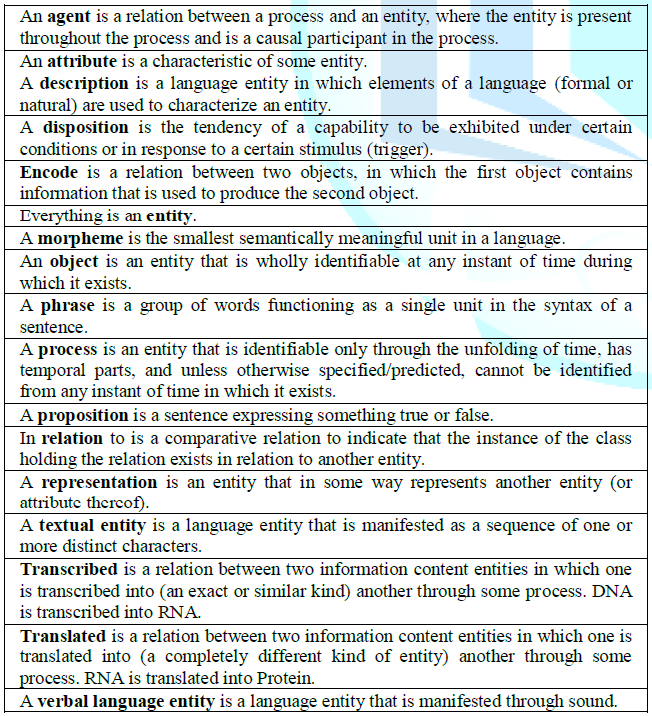
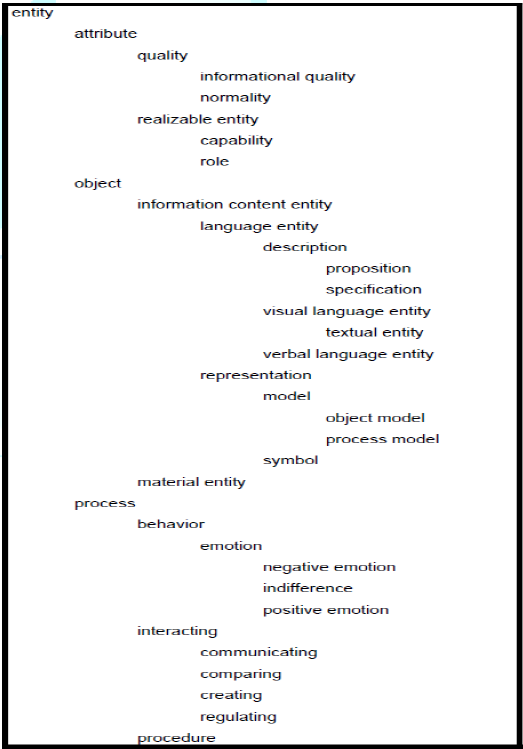
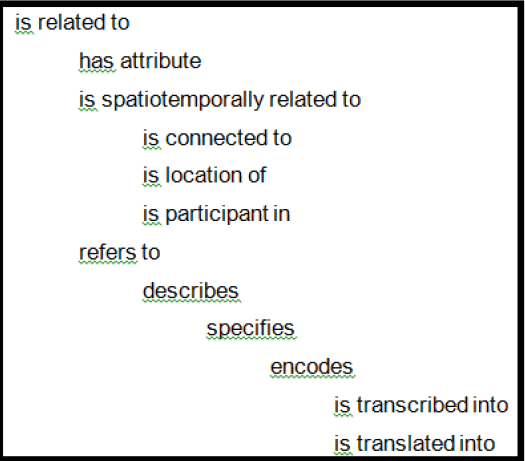
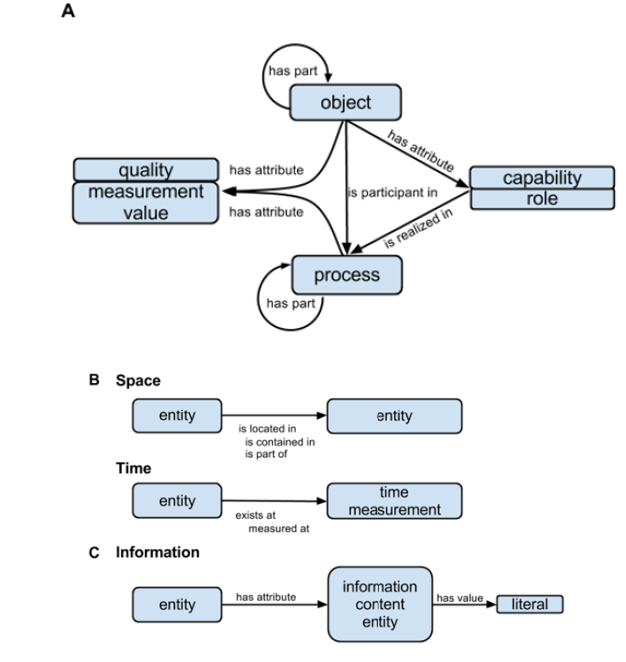
The design of the Semanticscience Integrated Ontology was motivated by the
need to integrate knowledge in biomedical research for the domains of biology,
chemistry, biochemistry, and bioinformatics. Examples of its application
therefore focused on genetics and molecular biology [8]. 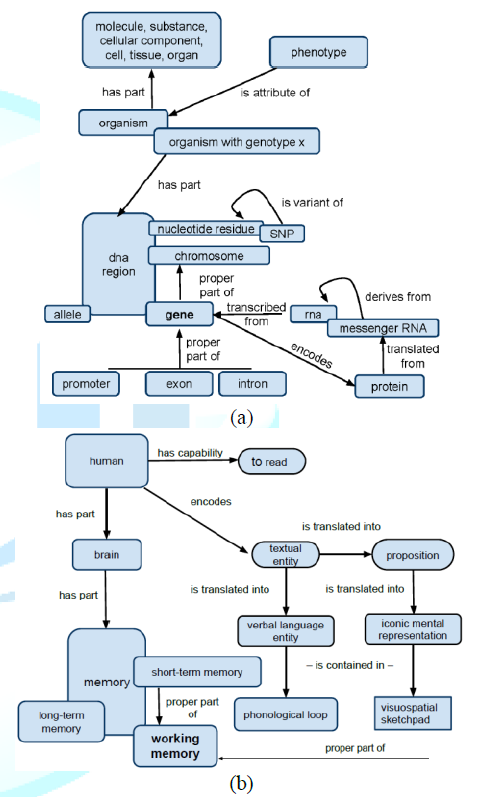
Adding Cognition to
SIO
In its most basic sense, information in SIO is an interpretable sequence of
symbols. Information arises from the interpretation of the symbols by some agent
using a decoding procedure. Decoding involves the parsing of the sequence and
the subsequent assignment of meaning.
Figure 3b shows the encoding and storing of information while reading a
text. The diagram is based on an information-processing perspective that
emphasizes different types of encoding and memory structures. As in Figure 3a,
overlap of one concept on another indicates a subclass relationship. Long-term
memory, short-term memory, and working memory are all types of memory.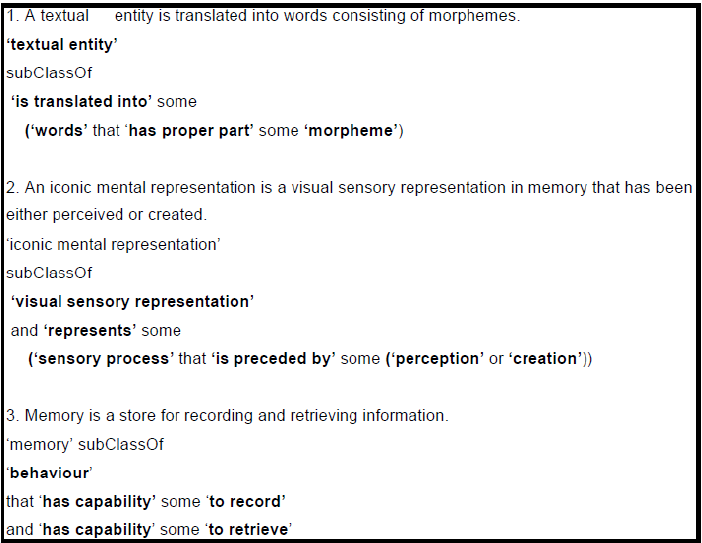
A potential problem with Baddeleys [18] working memory model is that it
incorporates only phonological and visuospatial information. Postle [21]
proposed that, instead of adding more modalities to the model, working memory
directs attention to the many different types of memory codes stored in LTM.
According this view working memory functions through the coordinated
recruitment of brain systems that have evolved to accomplish sensory-,
semantic- and action-related functions.
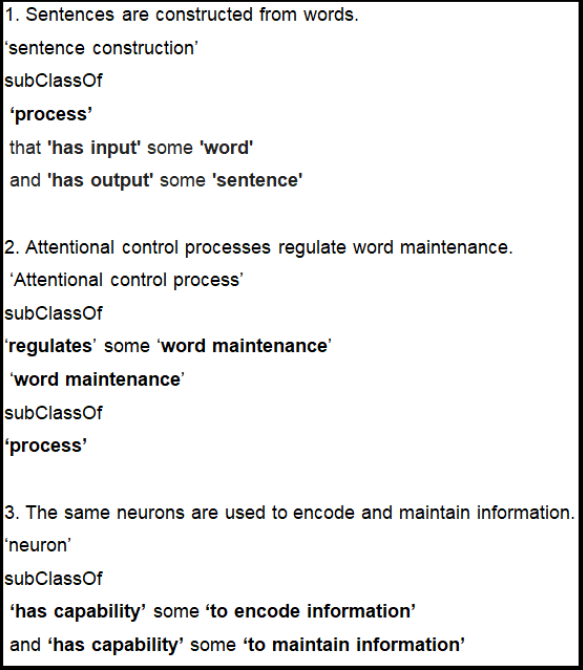
NIMH Research Domain
Criteria
Perhaps the most important taxonomy to organize psychological knowledge is
the ongoing development of the NIMH Research Domain Criteria (RDoC) described
on the NIMH website
http://www.nimh.nih.gov/research-priorities/rdoc/index.shtml. 
There is a growing interest in establishing and organizing a biological basis
of behavior [26] such as displayed in the columns of Table 2. In 2008 a group
of investigators argued that although biological knowledge at the genomic level
was progressing rapidly, informatics could help advance this research by
developing multi-level models [27]. They advocated a neuropsychiatric phenomics
strategy that progressed upward from genes, proteins, signaling (dopamine
signaling, synaptic development), neural symptoms (prefrontal function,
hippocampal function), cognitive constructs (working memory, response
inhibition), symptoms (psychotic, impulsive), and syndromes (schizophrenic,
ADHD). 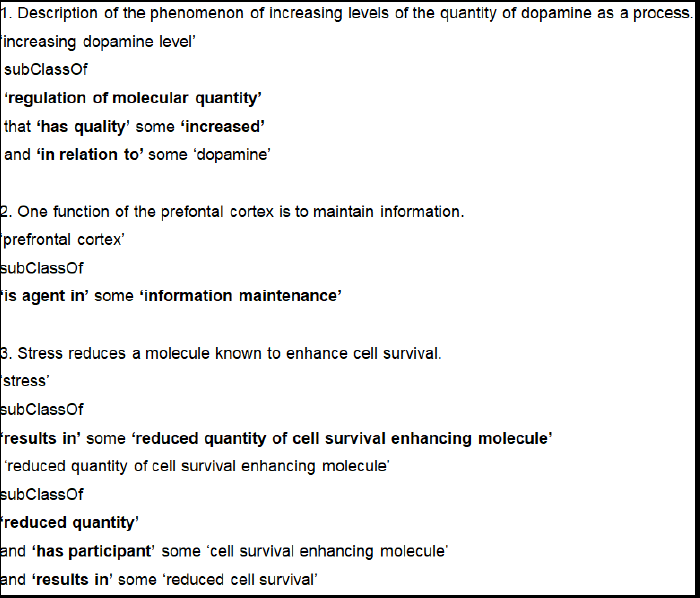
Dimensions of behavior include negative affect, positive affect, cognitive
systems, social processes, and arousal/regulatory systems as displayed in the
rows of Table 2. Auditory Verbal Hallucinations (AVH) are relevant to the RDoC
framework because, as illustrated in Figure 8, they involve several functional
dimensions of behavior such as negative affect, cognitive systems, and social
processes. 
Applications
One of the primary purposes of a formal representation of ontology is to
use deductive reasoning to answer queries. Answering queries becomes
challenging when the answer depends on a sequence of deductions based on
different stages of a disease. An example is a stage model that links stressful
life events to increased risk of disease [33]. The stages are [18] life events
[25] that are appraised as stressful, which result in [6] a negative emotional
response causing [34] disease related physiological changes.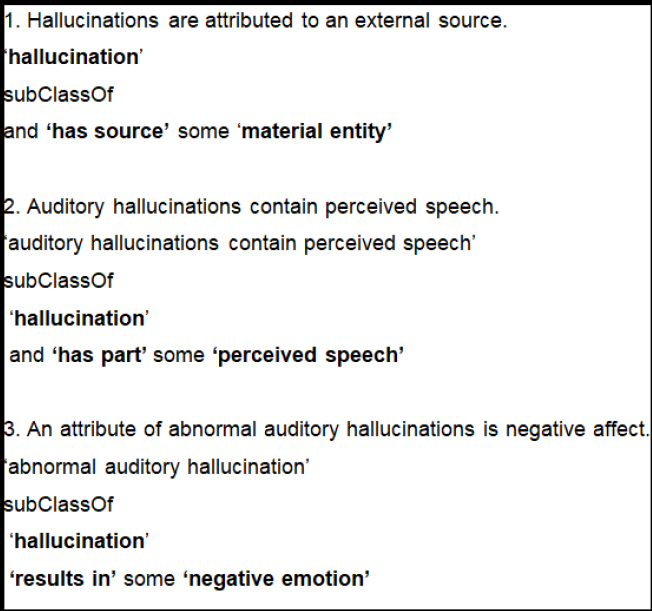
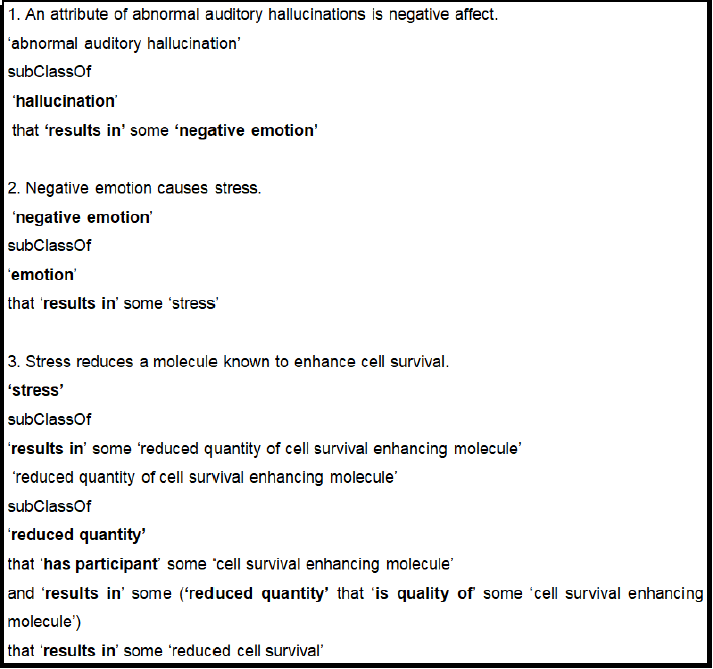

A limitation of the axioms in Fig. 10 of this article is that they are based
on the assumption that each of the causes has a probability of 1.0 of producing
the effect. A more realistic approach- WatsonPaths- expands on the Watson
question-answering system that became famous on Jeopardy [37]. The project in
collaboration with the Cleveland Clinic Lerner College of Medicine of Case
Western Reserve University presents a patient summary and asks for the most
likely diagnosis or most appropriate treatment. Guiding the diagnosis is a
model of entity types and relations. An application of these ontological
relations occurs in an assertion graph that connects input symptoms to
hypotheses. For instance, data that the patient exhibits a resting tremor
suggests that the patient has Parkinsons disease, which suggests that the
patients Substantia Nigra area of the brain is affected.
The development of accurate, personalized, and predictive models of
cognition that synchronize with our understanding of biology is crucial to the
advancement of cognitive science. A key aspect of this is to not only represent
general knowledge of cognitive processing, but also to integrate this in the
context of experimental results. For instance, reasoning over OWL ontologies
generated from computational models of systems biology revealed errors in human
curation as well as misuse of the model language. Complete formalization of
experimental knowledge, model, and simulation results not only enables queries
across all three, but also enables researchers to assess whether these are
consistent with one another [7]. By employing more sophisticated hypothesis
testing systems such as HyQue [25] it becomes possible to automatically
retrieve evidence from multiple databases that may support or dispute a
hypothesis or its associated claims. Of course, all of this becomes
substantially easier when communities come together to build shared
vocabularies for their research.Related Work
Concluding Remarks
Compliance with
Ethical Standards
References
Corresponding author:
Citation:
Keywords